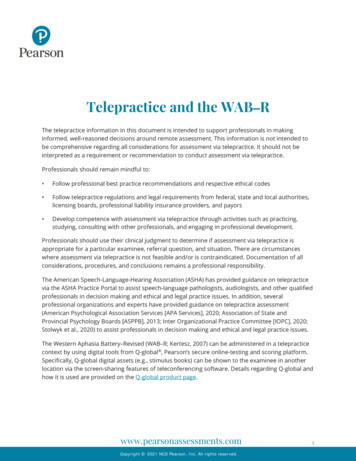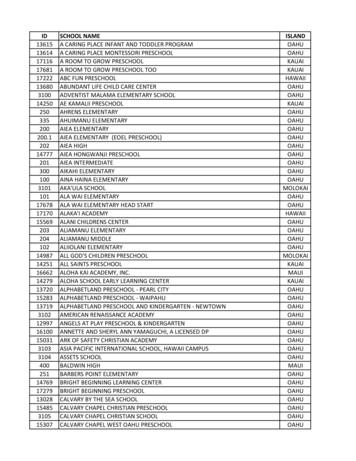
Transcription
Telepractice and the CELF Preschool–2and CELF Preschool–2 SpanishThe telepractice information in this document is intended to support professionals in makinginformed, well-reasoned decisions around remote assessment. This information is not intended tobe comprehensive regarding all considerations for assessment via telepractice. It should not beinterpreted as a requirement or recommendation to conduct assessment via telepractice.Professionals should remain mindful to: Follow professional best practice recommendations and respective ethical codes Follow telepractice regulations and legal requirements from federal, state and local authorities,licensing boards, professional liability insurance providers, and payors Develop competence with assessment via telepractice through activities such as practicing,studying, consulting with other professionals, and engaging in professional development.Professionals should use their clinical judgment to determine if assessment via telepractice isappropriate for a particular examinee, referral question, and situation. There are circumstanceswhere assessment via telepractice is not feasible and/or is contraindicated. Documentation of allconsiderations, procedures, and conclusions remains a professional responsibility.Several professional organizations and experts have provided guidance on telepractice assessment(American Psychological Association Services [APA Services], 2020; American Speech-LanguageHearing Association [ASHA], 2021; Grosch et al., 2011; Inter Organizational Practice Committee[IOPC], 2020; Stolwyk et al., 2020) to assist professionals in decision making and ethical and legalpractice issues.The Clinical Evaluation of Language Fundamentals Preschool–2 (CELF Preschool–2; Wiig et al., 2004)and the Clinical Evaluation of Language Fundamentals Preschool–2 Spanish (CELF Preschool–2Spanish; Wiig et al., 2009) can be administered in a telepractice context by using digital tools from Qglobal , Pearson’s secure online-testing and scoring platform. Specifically, Q-global digital assets(e.g., stimulus books) can be shown to the examinee in another location via the screen-sharingfeatures of teleconferencing software. Details regarding Q-global and how it is used are provided onthe Q-global product page.www.pearsonassessments.comCopyright 2021 NCS Pearson, Inc. All rights reserved.1
A spectrum of options is available for administering this assessment via telepractice; however, it isimportant to consider the fact that the normative data were collected via in-person assessment.Telepractice is a deviation from the standardized administration, and the methods and approachesto administering it via telepractice should be supported by research and practice guidelines whenappropriate.Professionals engaging in telepractice assessment may train facilitators to work with them on aregular basis in order to provide greater coverage to underserved populations (e.g., only twoprofessionals within a 500-mile radius, shortage of speech-language pathologists within a schooldistrict). For CELF Preschool–2 and CELF Preschool–2 Spanish, assistance from an on-site facilitator isnecessary due to the ages of the children tested. If such a facilitator is well trained and in aprofessional role (i.e., a professional facilitator), they can engage examinees in the PragmaticActivities Checklist (PAC) activities, adjust audiovisual equipment, and the examinee’s chair height sothe child is comfortable, positioning is stable, and the examiner can see his or her entire face. Thisapproach yields scores that are available in in-person assessment mode. If a professional facilitatoris not used, it impacts the workflow of the session, subtest selection, and the approach to derivingcomposite scores.In times when physical distancing is necessary (such as the COVID-19 pandemic), using aprofessional facilitator may not be safe or feasible. If testing must occur under these conditions, it ispossible that the examinee may participate with a caregiver as an on-site facilitator to assist thechild during the test session. Caregivers may address physical needs (e.g., providing a drink of wateror adjusting chair height), help maintain engagement, and/or troubleshoot technology issues. Aninitial virtual meeting should occur in advance of the testing session to address numerous issuesspecific to testing via telepractice. This initial virtual meeting is described in the ExaminerConsiderations section and referred to in various sections of this document. The examiner shouldconsider best practice guidelines, the referral question, and the examinee’s condition, as well astelepractice equivalence study conditions to determine if this is possible and appropriate. Examineeparticipation may not be possible or appropriate, for example, for young children.Professional and nonprofessional facilitators typically remain in the room with very young childrenthroughout the testing session. The caregiver must remain in the room, monitoring and addressingthe examinee’s practical needs, as well as any technological issues as necessary. The facilitator in theroom should always remain accessible. If a facilitator needs to leave the room for any reason, it isimportant that the examiner is able to contact the facilitator immediately if the examinee does notcooperate during testing, attempts to leave the room, or if there is a medical emergency. It is helpfulto have personal and local emergency numbers for each examinee.Conducting Telepractice AssessmentConducting a valid assessment in a telepractice service delivery model requires an understanding ofthe interplay of a number of complex issues. In addition to the general information on Pearson’stelepractice page, examiners should address five factors (Eichstadt et al., 2013) when planning toadminister and score assessments via telepractice:www.pearsonassessments.comCopyright 2021 NCS Pearson, Inc. All rights reserved.2
1. Telepractice Environment & EquipmentAssessment Materials & ProceduresExaminee ConsiderationsExaminer ConsiderationsOther Considerations1. Telepractice Environment & EquipmentComputers and ConnectivityTwo computers with audio and video capability and stable internet connectivity—one for theexaminer and one for the examinee—are required. A web camera, microphone, and speakers orheadphones are required for both the examiner and the examinee. A second computer screen orsplit-screen format on a large computer monitor for the examiner is helpful to allow a view of aPearson-delivered digital manual or administration directions, but the examiner can also use thepaper format manual or administration directions. The second computer screen or large screen alsotends to make sharing test content more straightforward for the examiner.Image/Screen SizeWhen items with visual stimuli are presented, the digital image of the visual stimuli on theexaminee’s screen should be at least 9.7” measured diagonally, similar to an iPad or iPad Air .Because some teleconferencing software shrinks the size of images, the image size should beverified in the initial virtual meeting. It is recommended that computer screens used forteleconference assessment be at least 15” measured diagonally. Smaller screens, such as those ofiPad minis, small tablet PCs, and smartphones, are not allowed for examinee-facing content, asthese have not been examined empirically and may affect stimulus presentation, examineeresponse, and validity of the test results. Similarly, presenting stimuli on extremely large screens hasnot been examined, so the same precaution applies. At the beginning of the testing session, theexaminer may ask for a peripheral camera or device (as described later in this section) to be aimedat the examinee’s screen to ensure that the examinee’s screen is displaying images in the correctaspect ratio and not stretching or obscuring the stimuli image.Audio ConsiderationsHigh-quality audio capabilities are required during the administration. An over the head, two-ear,stereo headset with attached boom microphone is recommended for both the examiner andexaminee. Headphones with a microphone may be used if a headset is not available.The examiner should test the audio for both the examiner and examinee in the initial virtualmeeting and at the beginning of the testing session to ensure a high-quality audio environment ispresent. Testing the audio should include an informal conversation before the administration wherethe examiner is listening for any clicks, pops, or breaks in the audio signal that distort or interruptwww.pearsonassessments.comCopyright 2021 NCS Pearson, Inc. All rights reserved.3
the voice of the examinee. The examiner should also ask if there are any interruptions or distortionsin the audio signal on the examinee’s end. Any connectivity lapses, distractions, or intrusions thatoccurred during testing should be reported.Audiovisual DistractionsAs with any testing session, the examiner should do everything possible to make sure theexaminee’s environment is free from audio and visual distractions. If the examiner is unfamiliar withthe examinee’s planned physical location, a visual tour of the intended testing room should be givenduring the initial virtual meeting. The examiner can then provide a list of issues to address totransform the environment into one suitable for testing. For example, remove distracting items,silence all electronics, and close doors. The examiner should confirm that these issues have beenaddressed at the time of testing. If possible, the examinee should be positioned facing away fromthe door to ensure the examiner can verify through the examinee’s camera that the door remainsshut and can monitor any interruptions. The examiner should confirm that all other applications onthe computer, laptop, or peripheral device are closed, the keyboard is moved aside or covered afterthe session is connected, and alerts and notifications are silenced on the peripheral device. Radios,televisions, other cellular phones, fax machines, smart speakers, printers, and equipment that emitnoise must be silenced and/or removed from the room.LightingGood overhead and facial lighting should be established for the examiner and examinee. Blinds orshades should be closed to reduce sun glare on faces and the computer screens.Teleconferencing SoftwareTeleconferencing software is required. Screen-sharing capability is required if anything other thanitems with verbal stimuli and responses are administered.VideoHigh-quality video (HD preferred) is required during the administration. Make sure the full faces ofthe examiner and the examinee are seen using each respective web camera. The teleconferencingsoftware should allow all relevant visual stimuli to be fully visible to the examinee when providinginstruction or completing items; the view of the examiner should not impede the examinee’s view ofvisual test stimuli.Peripheral Camera or DeviceA standalone peripheral camera can be used to provide a view of the session from another angle ora live view of the examinee’s progress. Alternately, a separate device (e.g., a smartphone with acamera or another peripheral device) can be connected to the teleconference and set in a stableposition to show the examinee’s pointing or written responses. The device’s audio should besilenced and microphone should be muted to prevent feedback. The examiner should guide thefacilitator to position the peripheral camera/device before administering written response tasks orwww.pearsonassessments.comCopyright 2021 NCS Pearson, Inc. All rights reserved.4
subtest that elicit pointing or gestured responses (refer to Table 1) so that the examiner can see thatthe examinee’s real-time responses are captured.In a typical telepractice session, it is helpful to set up an external camera in the examinee’s location.However, while physical distancing is necessary, the only camera available may be a stationarycamera integrated into the examinee’s laptop or computer screen. It may be necessary forexaminers to think creatively about how to use a smartphone or other device in the examinee’slocation to gain a view of the examinee when pointing at a screen. Before attempting this with afacilitator or an examinee, the examiner should work to become fluid and competent at directingexaminees in these methods, which can require extensive practice with varied individuals and typesof devices. In addition, this requires planning and practice in the initial virtual meeting to preventtechnical difficulties, and so the examinee feels confident doing this when it is time.Online instructional videos (e.g., here) demonstrate how a smartphone may be used with commonhousehold objects (e.g., a tower or stack of books, paper weight, ruler, and rubber band or tape) tocreate an improvised camera for use during tasks involving pointing. Similarly, for multiple choicetasks, some examinees tend to point to responses rather than say the number or lettercorresponding to their response, and other tasks require the examinee to point at the stimuli. In thissituation, other everyday household objects (e.g., books) could be used to form an improvised standupon which to position the device to provide a second-angle view of the examinee pointing at thescreen. A simple mirror behind the examinee has been used successfully to observe pointingresponses. Typically, devices provide the best view of the examinee’s screen and pointing responseswhen positioned in landscape orientation. While using additional cameras or devices/objects maynot be an optimal solution for telepractice, it can be functional if executed well.Screen Sharing Digital ComponentsDigital components are shared within the teleconferencing software as specified in Table 1. Thereare two ways to view digital components in the Q-global Resource Library: through the pdf viewer inthe browser window or full screen in presentation mode. Always use full screen (i.e., presentation)mode for digital components viewed by the examinee. This provides the cleanest presentation oftest content without on-screen distractions (e.g., extra toolbars). Refer to Using Your Digital Assets onQ-global in the Q-global Resource Library for complete directions on how to enter presentationmode.2. Assessment Materials & ProceduresTest Item SecurityThe examiner is responsible for ensuring test item security is maintained, as outlined in the Termsand Conditions for test use. The examiner should address test security requirements with theexaminee (and facilitator, if applicable) during the informed consent process. The examiner shouldmake it clear to the examinee/caregivers that the video should not be captured, photos should notbe taken, and stimuli should not be copied or recorded, as this is a copyright violation. Theexaminee must agree that they will not record (audio or visual) or take photos or screenshots of anyportion of the test materials or testing session, and not permit anyone to observe the testingwww.pearsonassessments.comCopyright 2021 NCS Pearson, Inc. All rights reserved.5
session or be in the testing room (except for a facilitator, when necessary). Any test-relatedmaterials used in the testing session must be returned to the examiner.DisruptionsThe examiner should record any and all atypical events that occur during the testing session. Thismay include delayed audio or video, disruptions to connectivity, the examinee being distracted byexternal stimuli, and any other anomalies. These can be noted on the record form or in the notessection on Q-interactive, if applicable, and should be considered during interpretation and describedin the written report. Refer to Other Considerations for guidance on report writing.Digital AssetsThe examiner should practice using the digital assets until the use of the materials is as smooth asan in-person administration. It is not recommended that the examiner display items from paperstimulus books on a camera. Refer to Using Your Digital Assets on Q-global in the Q-global ResourceLibrary for complete directions.GesturingWhen gesturing to the stimulus books or response booklets is necessary, the examiner shoulddisplay them as digital assets on-screen and point using the mouse cursor. It may on occasion benecessary for the examiner to gesture to areas of a paper copy of a response booklet or to showhow to respond to demonstration items (e.g., Coding) on the examiner’s camera. Refer to Table 1 forspecific instructions by subtest.Content ConsiderationsReview Table 1 for the specific telepractice considerations for each subtest to be administered.www.pearsonassessments.comCopyright 2021 NCS Pearson, Inc. All rights reserved.6
Table 1. Specific Telepractice ConsiderationsSubtest(s)All subtestsConsiderations Requires high-quality audio and video for examinee and examiner.Sentence Structure/Estructura de oracionesBasic Concepts/Conceptos básicosWord Classes/Clases de palabras Examiner points with the mouse to indicate stimuli on-screen. Examinee must indicate responses by pointing to picture(s).Peripheral camera/device should be placed in a stable position thatshows examinee’s screen and provides a view of the examinee’spointing response.Concepts & FollowingDirections/Conceptos y siguiendodireccionesWord Structure/Estructura de palabrasExpressive Vocabulary/Vocabulario expresivoRecalling Sentences/Recordando gicoPragmatics Profile/Clasificación pragmáticaPreliteracy Rating Scale/Escala de valoración dealfabetización temprana Examiner points with mouse to indicate visual stimuli (i.e., picture orwords) on-screen while also presenting a verbal stimuli. Examinee responds verbally.Connected Speech Sample: Examiner presents visual and verbalstimuli (i.e., entire short story) at one time. Examinee respondsafter all visual and verbal stimuli have been presented. Examiner presents verbal stimuli. Examinee responds verbally. Recalling Sentences/Recordando oraciones: Do not repeat items unlessit was not heard due to technical problems Requires another person (respondent) to complete the rating scale. Rating scales may be mailed to the respondent(s) before or after testadministration, or may be conducted as an interview. Pragmatics Profile: Requires either a classroom teacher’s orparent’s/caregiver’s input. Preliteracy Rating Scale: Requires a classroom teacher’s orparent’s/caregiver’s input.Evaluating Equivalence EvidenceExaminers should review the current research available on equivalence between different modes ofadministration before proceeding to use remote administration of a standardized assessment withnormative data collected via in-person assessment. When reviewing the literature, the examinershould consider the input and output requirements for each task, and the evidence available forwww.pearsonassessments.comCopyright 2021 NCS Pearson, Inc. All rights reserved.7
telepractice equivalence for the specific task type. Direct evidence of equivalence for a specific taskmay be available because the task was researched in a study with results indicating no significantdifference between telepractice and in-person assessment. Indirect evidence may also be reportedin the literature for a task that is similar in construct and input/output demands to the standardizedassessment being considered for remote administration and may help determine the examiner’slevel of confidence in applying the norms. For instance, a study demonstrating direct evidence forthe Repeatable Battery for the Assessment of Neuropsychological Status (RBANS) Picture Namingsubtest also demonstrates valuable indirect evidence for the WISC-V Vocabulary and CLQT Confrontation Naming subtests because Picture Naming, Vocabulary, and Confrontation Naming allrequire brief spoken directions with pictorial stimuli inputs with open-ended spoken responseoutputs. Examiners can have more confidence that the normative scores are valid when tasks havedirect evidence showing equivalency between modes.In reviewing the literature of telepractice–in-person and digital–traditional investigations,professionals should also be mindful of the age range and population (e.g., clinical group) of theresearch study to consider relevancy for the examinee. Greater caution is recommended when onlyindirect evidence of equivalency is available for a task, or when equivalence has not beenestablished for a particular examinee’s age range and clinical condition. However, it can beinformative to consider any such available evidence when considering impact of remoteadministration on results and interpretation. Pearson Clinical Assessment is tracking andaggregating the relevant equivalence evidence for our assessments, including the age range,population, direct evidence, and indirect evidence (see Evidence for Remote Assessment).Table 2 lists the input and output requirements of each task. The abbreviations in the Input andOutput column correspond to the various input and output requirements of each task, and a keyappears at the bottom of the table. For example, brief spoken directions as an input requirement isabbreviated as BSD.Table 2. Input and Output RequirementsTaskSymbols á é ë í ó ú ü ñInputaBSD, PS, SSOutputbMC, PRBSD, PS, SSSPRSentence Structure/Estructura de oracionesBasic Concepts/Conceptos básicosWord Classes/Clases de palabrasConcepts and Following Directions/Conceptos y siguendo direccionesWord Structure/Estructura de palabrasExpressive Vocabulary/Vocabulario expresivowww.pearsonassessments.comCopyright 2021 NCS Pearson, Inc. All rights reserved.8
TaskRecalling Sentences/Recordando oracionesInputaBSD, SSOutputbSPRBSD and/or SSBSR or WFRPhonological Awareness/Conocimiento fonológicoPragmatics Profile/Clasificación pragmáticaPreliteracy Rating Scale/Escala de valoración dealfabetación tempranaNote. aInput abbreviations are: BSD Brief spoken directions, PS Pictorial stimuli, SS Spoken stimuli.bOutput abbreviations are: BSR Brief spoken response, MC Multiple choice, PR Pointing response, SPR Spoken response, WFR Writtenor fine motor response.3. Examinee ConsiderationsAppropriatenessThe examiner should first ensure that a telepractice test administration is appropriate for theexaminee and for the purpose of the assessment. Clinical judgment, best practice guidance fortelepractice (e.g., APA Services, 2020; ASHA, 2021; Association of State and Provincial PsychologyBoards [ASPPB], 2013; ASPPB, 2013; IOPC, 2020), information from professional organizations andother professional entities (e.g., licensing boards, legal resources, professional liability insuranceproviders, payors), consultation with other knowledgeable professionals, existing research, and anyavailable federal or state regulations should be considered in the decision-making process.Consideration should be given to whether the necessary administrative and technological tasksinvolved in a telepractice session can be accomplished without influencing results.PreparednessBefore initiating test administration, the examiner should ensure that the examinee is well-rested,able, prepared, and ready to appropriately and fully participate in the testing session.Facilitator RoleIf using a facilitator, the role of the facilitator must be explained to the examinee so participationand actions are understood.HeadsetIt may not be appropriate or feasible for some examinees to use a headset due to behavior,positioning, physical needs, or tactile sensitivities, or if a headset is not available. Clinical judgmenton the appropriate use of a headset in these situations should be used. If a headset is not utilized,the examiner’s and examinee’s microphones and speakers should be turned up to a ght 2021 NCS Pearson, Inc. All rights reserved.9
MouseOn some teleconferencing software, the examiner can pass control of the mouse to allow theexaminee to point to indicate responses; this is an option if it is within the capabilities of theexaminee. However, best practice guidelines provide cautions about this. For example, the IOPCguidelines suggest examiners be alert throughout administration, resume control of the screen oncethe task is finished, and never leave the computer unattended while the examinee has control overthe examiner’s computer (IOPC, 2020).4. Examiner ConsiderationsPracticeDuring the telepractice setup, and before administering to any actual examinee, the examinershould rehearse the mechanics and workflow of every item in the entire test using the selectedteleconferencing software so that the examiner is familiar with the administration procedures. Forexample, a colleague could be used as a practice examinee.Standardized ProceduresThe examiner must follow the administration procedures of in-person administration as much aspossible. For example, if a spoken stimulus cannot be said more than once in in-personadministration, the examiner must not say it more than once in a telepractice administration unlessa technical difficulty precluded the examinee from hearing the stimulus.Real-Time TroubleshootingIn order to conduct a smooth telepractice session, audiovisual needs and materials must bemanaged appropriately. The initial virtual meeting involves the examiner, examinee, and/or thefacilitator (if used), and is the opportunity for the examiner to provide information about theaudiovisual needs and materials. During the initial virtual meeting, the examiner should providetraining in troubleshooting audiovisual needs that arise during the testing session, including cameraangle, lighting, and audio checks. The examiner should provide verbal feedback to guide cameraadjustment, checking the on-screen video shown by the peripheral camera/device to provideinformation about how to reposition it until the proper view is shown. The examiner shouldemphasize that no materials should be opened until the examiner provides instructions to do so, ifapplicable. The examiner should also expect to provide verbal guidance about these issues duringthe testing session. Refer to the Telepractice Environment & Equipment section and to Table 1 forspecific subtest telepractice considerations.Collaborating With FacilitatorsIf used, the facilitator is to assist with administrative and technological tasks and not to managerapport, engagement, or attention during the testing session. The examiner should direct them notto interfere with the examinee’s performance or responses. Any other roles and responsibilities forwhich an examiner needs support, such as behavior management, should be outlined and trainedwww.pearsonassessments.comCopyright 2021 NCS Pearson, Inc. All rights reserved.10
before the beginning of the testing session. The examiner is responsible for documenting allbehaviors of the facilitator during test administration and taking these into consideration whenreporting scores and performance.5. Other ConsiderationsThere are special considerations for written reports describing testing that takes place viatelepractice. The professional completing the written report should state in the report that the testwas administered via telepractice, and briefly describe the method of telepractice used. Theprofessional should also make a clinical judgment, similar to an in-person session, about whether ornot the examiner was able to obtain the examinee’s best performance. Clinical decisions should beexplained in the report, including comments on the factors that led to the decision to conducttesting via telepractice and to report all (or not to report suspect) scores. In addition, it isrecommended that the report include a record of any and all atypical events during the testingsession (e.g., delayed video or audio, disruptions to connectivity, extraneous noises such as phoneringing or loud dog barking, person or animal unexpectedly walking into room, the examineeresponding to other external stimuli). List and describe these anomalies as is typical for reportingbehavioral observations in the written report, as well as any observed or perceived impact on thetesting sessions and/or results, and consider these in the interpretation of results.An example of a written report might include:“The CELF Preschool–2 was administered via remote telepractice using digital stimulus materialson Pearson’s Q-global system, and a facilitator monitored the administration on-site during thelive video connection using the [name of telepractice system, e.g., Zoom] platform. The remotetesting environment appeared free of distractions, adequate rapport was established with theexaminee via video/audio, and the examinee appeared appropriately engaged in the taskthroughout the session. No significant technological problems or distractions were noted duringadministration. Modifications to the standardization procedure included: [list]. The CELFPreschool–2 subtests, or similar tasks, have received initial validation in several samples forremote telepractice and digital format administration, and the results are considered a validdescription of the examinee’s skills and abilities.”Notes may be recorded about any testing issues on the record form or in the notes section on Qinteractive.ConclusionThis test was not standardized in a telepractice mode, and this should be taken into considerationwhen utilizing this test via telepractice and interpreting results. For example, the examiner shouldconsider relying on convergence of multiple data sources and/or being tentative about conclusions.Provided that the examiner has thoroughly considered and addressed the factors and the specificconsiderations as listed above, the examiner should be prepared to observe and comment aboutthe reliable and valid delivery of the test via telepractice. Materials may be used via telepracticewithout additional permission from Pearson in the following published contexts:www.pearsonassessments.comCopyright
licensing boards, professional liability insurance providers, and payors Develop competence with assessment via telepractice through activities such as practicing, . shortage of speech-language pathologists within a school district). For CELF Preschool-2 and CELF Preschool-2 Spanish, assistance from an on-site facilitator is .










